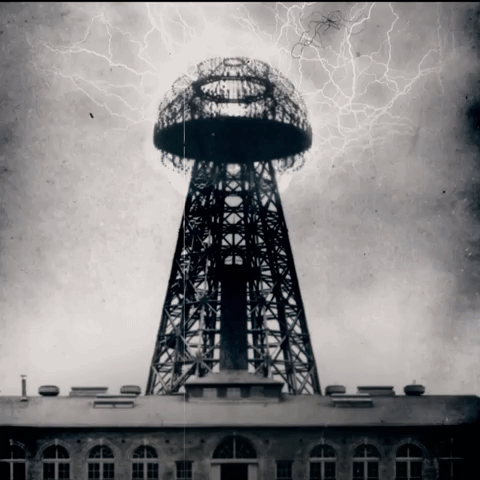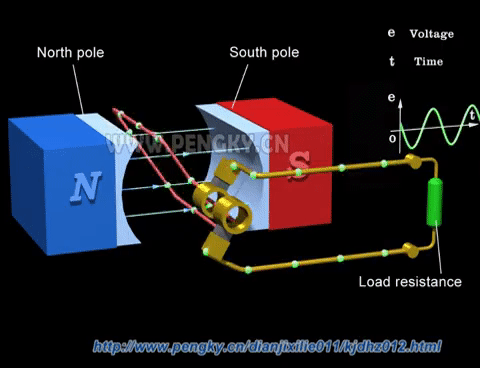In the introductory post of this series, I talked about virtual power plants and how they help stabilise the grid. When there is too much power in the grid, they pull power from it; and when there’s a lack of power in the grid, they feed in power. How do they know whether there’s too much or not enough power in the grid? They know it by measuring the frequency of the grid. But what does that even mean? What is the “grid frequency” a frequency of? Like a lot of things in power grids, this topic is not exactly rocket science — in fact, it’s quite simple. In this post, I hope to explain it in a way that makes you think so too.

Before we dive in, here’s a little heads up, though. In the next two paragraphs, I’m going to have to talk about nasty terms like voltage and alternating current. Ugh. We’ll get through them in no time, though, and then I promise it’ll be all be back to fun and games. Let’s get to it then!
The Flow of Electrons
When you plug a device into a socket and turn it on, electrons from the power outlet start flowing through your device. Your device works by converting the flow of electrons into other types of energy like light, heat, moving something, etc. This is the first important thing to note — your vacuum cleaner doesn’t eat up electrons that come from your socket, it just uses the energy those flowing electrons have to spin a fan. It’s just like a watermill using the flow of water to turn.
Now, unlike a stream under a watermill, those electrons don’t need to flow in one direction the whole time for us to be able to make use of them. They can also “flow” back and forth. Some devices like a nice, constant flow in the same direction — called direct current, DC; while others prefer a back and forth flow — called alternating current, AC. It is called alternating because it alternates the direction of the current of electrons. As an example — your computer and other small electronics usually work on DC, while devices containing motors, like your washing machine, usually work on AC.
It is fairly easy to convert between AC and DC (which is why you can have both kinds of devices in your household), but for our quest to understand what grid frequency is, it is important to note that in the power grid, electrons are flowing back and forth, meaning it is an AC grid. This was in fact no easy decision, but it is the result of a series of decisive events called The War of the Currents (no kidding). I would like to take this opportunity to commend the 19th century reporters for coming up with such a rad name.
Back and Forth
One of the reasons why AC won The War of the Currents was that devices for generating large amounts of AC power (AC generators) were fairly simple in design. Let’s take a look at how they work.
Most conventional power plants use steam, water, or wind to rotate a turbine. The turbine then either rotates a magnet inside some copper coils, causing the electrons in the coils to move around; or it rotates coils inside a magnetic field, again causing the electrons in the coils to move around (pictured below). In both cases, changing the direction of the poles of the magnet with respect to the coil causes the stream of electrons flowing inside the coil to change direction, i.e. produces alternating current.

What’s actually changing in the generator is the voltage — alternating between positive and negative. But voltage is such an alien word —humans don’t really experience the effect of voltage in everyday life (and let’s keep it that way), as we do with other physical quantities like force, heat, energy and so on. Luckily, voltage has two alter egos that are much more descriptive — electrical pressure and electrical tension. What these alter egos are trying to tell us is that we can actually imagine voltage as the difference in pressure between two ends of a wire. This difference in pressure causes electrons to flow, just like the difference in air pressure causes wind to blow.
As for the AC generator, I like to imagine it as if the turbine was controlling a piston, and the piston was pushing and pulling the electrons in a pipe. When the piston is pushing into the pipe, it’s increasing the pressure on that end of the pipe, causing the electrons to flow away from it. When it’s pulling back, it’s creating tension on its end of the pipe, causing the electrons to flow towards it.
I thought I Came Here to Read About Frequency
I think we can finally answer the question “What is the grid frequency a frequency of?” It is the frequency of voltage cycles in the grid, i.e. of the voltage going from the highest to its lowest, and back to its highest point. In other words, it is the frequency of the electrons flowing back and forth. In Europe, the grid frequency is 50 Hz, meaning the electrons in the power lines go back and forth 50 times in one second, or the voltage goes from 325V down to -325V and back to 325V 50 times in a second in your power outlet. Most importantly, this frequency is directly dependent on and synchronised with the rate of turning of the turbines (their revolutions per minute) in all the power plants.
How Does that Relate to the Balance of Production & Consumption?
When you turn on a device, the flow of electrons in it provides the device with energy, but this represents a resistance (or load) on their flow, i.e. a load on the grid. As you keep increasing the load, it’s going to be harder and harder for the turbines in the power plants to keep pushing and pulling the electrons, i.e. harder to keep spinning at the same rate, and they’ll start slowing down (less revolutions per minute), thus making the frequency drop.
It’s like riding a bike. I’m going to have to go full hipster, and ask you to imagine riding a fixie at a constant speed on a flat road. Since you’re riding at a constant speed, you are turning your pedals at a constant frequency.

This is how all the power plants feel when our consumption is exactly as they planned, and they’re purring away happily at 50 Hz.
Next, the road starts to go uphill, making it harder for you to maintain your speed, and you start pedalling slower, i.e. you reduce the frequency of your pedalling.

When consumption (load) on the grid rises above planned levels, the power plants feel like they are now cycling uphill, causing their turbines to spin slower — below 50 Hz.
You now reach the top of the hill, and start going downhill, causing your fixie to accelerate and your pedals to turn faster than you’d like them to.

When there’s less load than planned in the grid, the power plants are producing with too much power, causing their turbines to spin faster (as if they were cycling downhill) and the frequency to rise — above 50 Hz.
Errm… Why are you telling me this, again?
Because virtual power plants! When the grid frequency is too high — meaning there’s too little load on the grid — the sonnen VPP increases the load by charging the sonnen batteries in customers’ homes from the grid. When the frequency drops — meaning there’s too much load or conversely too little production — the VPP discharges power from the batteries into the grid, thus increasing production. I explained how virtual power plants work in more detail in this post.
I find the challenges of modern energy generation and power grids fascinating, and I feel galvanized to help solve them as quickly as possible. This is why I will try to clarify these challenges in a series of blog posts, along with our ideas and attempts at tackling them.
Am I doing a good job? Was that interesting and understandable? Did I share some horrible misinformation? Do you disagree with me? Do you have any questions? Please let me know in the comments or on LinkedIn, or on Twitter :)
